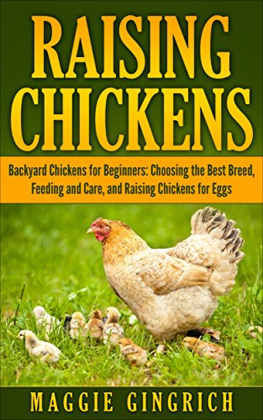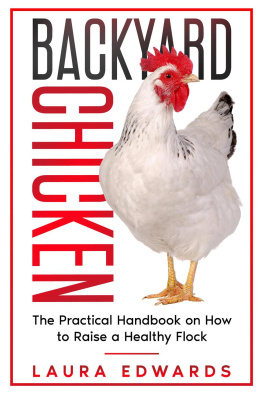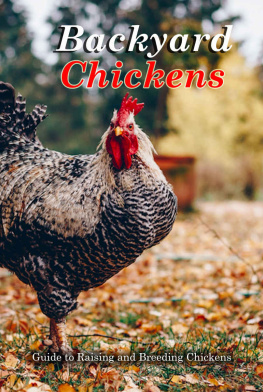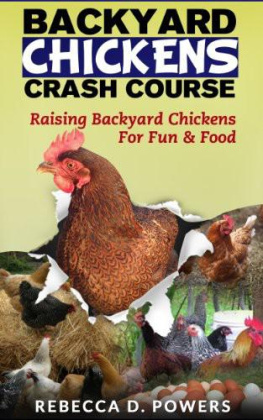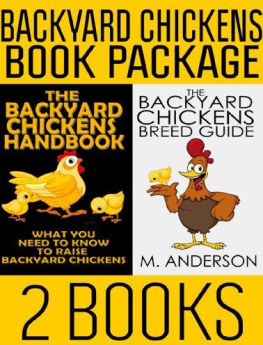Raising Backyard Chicken Handbook
The Complete Guide to Raising Chicken for Beginners
Copyright 2020
All rights reserved.
DEDICATION
The author and publisher have provided this e-book to you for your personal use only. You may not make this e-book publicly available in any way. Copyright infringement is against the law. If you believe the copy of this e-book you are reading infringes on the author's copyright, please notify the publisher at: https://us.macmillan.com/piracy
CONTENTS
In troduction
Welcome to Raising Backyard Chicken Handbook. This book contains everything you need to know about this fantastic hobby to get you started.
There is, if truth be known no economic benefit in keeping chickens at home for eggs these days but the difference in freshness and quality beats shop bought eggs by a long way and the pleasure in seeing a group of hens scratching around the garden providing you with a daily dose of amusement as well as organic bug control makes them so worth while. If you follow a few basic ideas, youll be keeping happy, healthy chickens in no time.
If you ever get the chance to visit a battery farm, I would say you definitely should. Ex-Battery hens lead a terribly miserable life and the space these girls have (or dont have!) in their cage truly needs seeing to believe. Personally, I have found an appreciation of what free-range really means by seeing how we have farmed chickens so intensively. By keeping some chickens in the back garden, you are able to enhance their quality of life immeasurably in comparison to the humble battery hen.
Good luck and hope you get as much pleasure out of your hens!
Things to Consider before Getting Chickens
First, check local town ordinances to ensure that keeping chickens is even allowed in your neighborhood or if there is a limit to the number of chickens you can keep at once. The last thing you want is to invest time and money into preparing for chickens and then find out that you cant even keep them!
Make sure you have the space for a henhouse or a full-size chicken coop. It has to hold a feeder and water containers, a roosting area, and a nest box for every three hens. A proper coop should be large enough that you can stand in it to gather eggs and shovel manure comfortably, but a simple henhouse can be quite a bit smaller. Plus, any housing must be sturdy enough to keep your chickens safe from all the predators out there!
Chickens need food (and water) daily. Feed is about $20 per 50-pound bag at my co-op, but prices vary depending on your location and the quality of the feed. How long a bag lasts depends on the number of chickens that you have.
Hens will lay eggs through spring and summer and into the fall, as long as they have 12 to 14 hours of daylight. Expect to collect eggs daily, or even twice a day.
All year round, youll have to shovel manure. Yippee!
If you go away on vacation, youll need a reliable chicken-sitterand they can be scarcer than hens teeth!
How Much Does Keeping Chickens Cost?
All of this costs money, of course. The materials to build and furnish a coop and a 20x5-foot runincluding wood, fencing, and hardwareare going to set you back at least $300. If you cant do this work yourself, youll also be buying skilled labor.
Overall, expect to spend between $500 and $700 when just getting started, depending on the size of your flock, coop, and run.
What Should I Look Out For?
All birds should have clear, bright eyes. They should be curious about their environment and you. Feathers or fluff should look clean with good coloring.
If a bird, regardless of age exhibits any of these signs you should avoid buying it.
Sleepy, lethargic
Hunched into a ball
Sitting by itself
Reluctant to move
Any nasal/eye discharge
Blocked vent
Step 1: Choosing A Breed
How many different breeds are there?
Truthfully, no-one really knows, but it is estimated to be in the hundreds. There are birds that have been specifically bred for enhanced egg laying, quality meat, fighting and plumage.
Whilst there are lots of breeds of chickens, they all fall into one of four categories:
Heritage Breeds: The Livestock Conservancy defines a Heritage chicken as a natural breeding chicken that has a slow growth rate and can live a long, productive outdoor life. The breed must also conform to the American Poultry Associations standard for that breed.
Egg Laying Breeds: These hens have been bred to produce large quantities of eggs through their short production lifetimes. The list of top performers goes something like this:Australorp, Delware, New Hampshire, Buckeye, Plymouth Rock, Sussex, Brown Leghorn
Dual Purpose Breeds: These hens are the best of both worlds in utility terms. They are productive in the egg department and also grow large enough to be used as a meat bird later on in their life.
Meat Breeds: As the name suggests these breeds of chicken are bred for meat purposes. They grow very, very quickly. They put on weight at an alarming rate and are ready for slaughter at around nine weeks. If your looking for a great meat breed here are our top 3 picks: Cornish cross, Bresse, Jersey Giants
Step 2: Getting Your Chickens
Its time to take the plunge! You want chickens and know which breed youd like but arent sure where to start.
When you get chickens for the first time you have a few different choices.
We are going to look at the good and bad of each option. You can buy hatching eggs, chicks, started pullets or adult birds. Each choice has its merits but its really about what you feel is best for you.
Financially, the cheapest option is the chicks.
Pullets will cost you more because of the care, feed and time expended to raise the bird. Adult hens in their prime are the most expensive. Rescue and ex-battery hens are usually cheaper than pullets but more expensive than chicks.
Hatching Eggs: These are fertilized eggs that you need to incubate. If you are new to chickens, I dont recommend that you get hatching eggs unless you really know what you are doing. Although incubation is fairly straightforward, there definitely is an art to it.
Chicks: This is the most used and wise choice for novices. You can select which breed(s) you want and when you want them. You typically get chicks at one day old.
Pullets: Pullets are birds aged between four to six months. The chicks have been reared to adulthood and are usually sold at point of lay, meaning the pullet is about to lay her first egg anytime soon!
Adults: Adult hens are more difficult to come by as breeders like to move birds out before they get too old since they eat more. A common source of adult hens is animal shelters or rescue sanctuaries.


